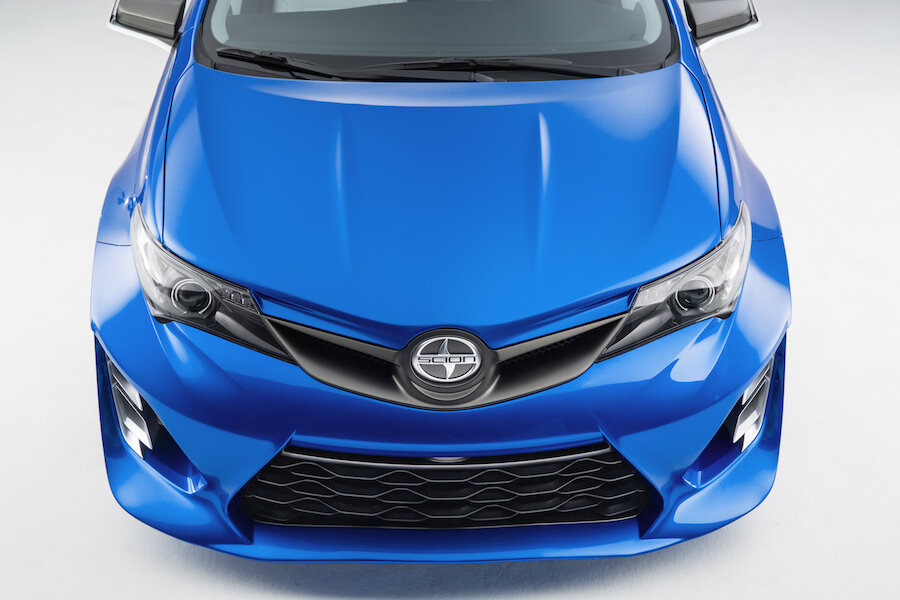Can well-equipped, affordable Scion iA, iM break the brand's sales slump?
Scion needs a sales hit, and it needs it quickly.
Launched 12 years ago, Toyota's youth-oriented division found initial success with the offbeat personality of its boxy xB hatchback and the Scion tC coupe's sporty style. Other models fared less well with Scion's target market. The conventionally styled xA and xD hatchbacks never really caught on, nor did the iQ microcar, and all have been dropped from the lineup.
Then there's the FR-S sports car, developed alongside the nearly identical Subaru BRZ, which has seen a steady drop in sales following an initial frenzy when it hit dealerships in 2012.
Things had gotten so bad by 2013, long after the brand's sales apex in 2006, that Toyota told its dealers they could walk away from Scion franchises without any penalty.
The struggling carmaker hopes to revive its fortunes by attracting a new generation of under-30s with a pair of all-new models for the U.S. market: the iA sedan and iM hatchback. They'll reach Scion showrooms on the same day—September 1—and, even more curiously, they'll share a marketing campaign.
Now, this approach might seem conventional if the iA and iM were closely related variants built on the same platform, but these cars weren't even developed by the same manufacturer. Beneath a halfhearted veneer of Scion badging and design cues, the iA is a Mazda 2. Think of the iM, meanwhile, as a reboot of the Toyota Matrix—under its fashionable hatchback bodywork lurks the mechanicals of a workaday Corolla.
The difference between the two cars was especially evident during back-to-back drives during a recent press event in Malibu.
On paper, the iA looks like the weaker performance entry. Its diminutive 1.5-liter four-cylinder engine produces a scant 106 horsepower and 103 pound-feet of torque. And, indeed, no one would accuse of it being quick off the line with either of its transmissions: a six-speed manual or six-speed automatic with sport mode. But it weighs an equally scant 2,400 pounds, and the iA feels lively once underway.
Most buyers will choose the automatic transmission, which does a good job and delivers superior estimated EPA ratings of 33/42/37 mpg. Those who opt for the manual will, however, find a slick-shifting gearbox that's truly enjoyable to operate and still returns an estimated 31/41/35 mpg.
The iM's 1.8-liter four-cylinder is a bit more powerful at 137 horsepower and 126 pound-feet of torque. But it also has 3,000 pounds to move, and likewise suffers from sluggish initial acceleration with both available transmissions: a six-speed manual or a seven-speed continuously variable transmission (CVT) with seven virtual speeds and a sport mode.
Oddly, the iM's CVT is the transmission of choice for performance-oriented driving, keeping revs in the sweet spot for spirited maneuvers while mimicking the natural feel of a traditional automatic. The manual transmission, by contrast, suffers from long throws, imprecise action, and long clutch travel. It's just as well that the CVT's estimated EPA ratings of 28/37/32 mpg best the manual's 27/36/31 mpg.
On the road, the iA belies its bargain pricing with good feel from its electric power steering, confident handling characteristics, and a compliant ride that absorbs imperfections. It feels like a larger, more expensive car than it is.
Though the iM handles well enough, uncommunicative steering makes it difficult to identify limits; there's also a fairly jittery ride that can feel unsettled even on smooth pavement.
Both the iA and the iM offer plenty of mono-spec content for their no-haggle MSRPs. The iA has premium features like push-button start, while the iM boasts features like dual-zone automatic climate control and power folding mirrors. But Scion needs to cut costs somewhere, and each model is afflicted with cheap-looking upholstery on the seats and doors.
The iA seems again to gain the upper hand when comparing the usability of interior space. Though neither has generous rear headroom, for instance, taller passengers might be more comfortable in the iA. Likewise, even though the hatchback iM has an overall advantage when its 60/40 seats are folded flat, its smallish cargo bay can't match the iA's large, well-shaped trunk when seats aren't folded.
Whether the iA and the iM will pull Scion out of its sales slump remains to be seen. The iM has style, versatility, and the allure of Corolla-like reliability; the fact that there isn't an equivalent Toyota hatchback might also steer buyers to Scion's side of the showroom. But the real star of Scion's new launches is the iA. And how often is that true of a base model with a base transmission and a base price under $16,000?






